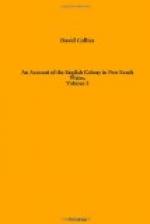The fore legs are very strong and muscular: their length, to the sole of the paw, is five inches five tenths, and the distance between them is five inches and five tenths. The paws are fleshy, round, and large, being one inch and nine tenths in diameter. Their claws are five in number, attached to as many short digitations. The three middle claws are strong, and about eight or nine tenths of an inch in length; the thumb and little finger claws are also strong, but shorter than the others, being only from six to seven tenths of an inch. The fleshy root of the thumb claw is smaller and more flexible than the others. The sole of the paw is hard, and the upper part is covered with the common hair, down to the roots of the claws which it overhangs. The hind legs are less strong and muscular than the fore; their length, to the sole, is five inches and five tenths; the distance between, seven inches and five tenths. The hind paw is longer than the fore, but not less fleshy; its length is two inches and seven tenths, its breadth two inches and six tenths. The claws are four in number: the three inner ones are less strong, but about two tenths of an inch longer than the longest of the fore claws; and there is a fleshy spur in the place of a thumb claw. The whole paw has a curve, which throws its fore part rather inward.
In size the two sexes are nearly the same, but the female is perhaps rather the heaviest.
In the opinion of Mr. Bass, this Wombat seemed to be very economically made; but he thought it unnecessary to give an account of its internal structure in his journal.
This animal has not any claim to swiftness of foot, as most men could run it down. Its pace is hobbling or shuffling, something like the awkward gait of a bear. In disposition it is mild and gentle, as becomes a grass-eater; but it bites hard, and is furious when provoked. Mr. Bass never heard its voice but at that time; it was a low cry, between a hissing and a whizzing, which could not be heard at a distance of more than thirty or forty yards. He chased one, and with his hands under his belly suddenly lifted him off the ground without hurting him, and laid him upon his back along his arm, like a child. It made no noise, nor any effort to escape, not even a struggle. Its countenance was placid and undisturbed, and it seemed as contented as if it had been nursed by Mr. Bass* from its infancy. He carried the beast upwards of a mile, and often shifted him from arm to arm, sometimes laying him upon his shoulder, all of which he took in good part; until, being obliged to secure his legs while he went into the brush to cut a specimen of a new wood, the creature’s anger arose with the pinching of the twine; he whizzed with all his might, kicked and scratched most furiously, and snapped off a piece from the elbow of Mr. Bass’s Jacket with his grass-cutting teeth. Their friendship was here at an end, and the creature remained implacable all the way to the boat, ceasing to kick only when he was exhausted.




